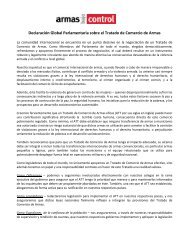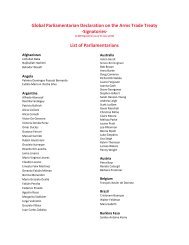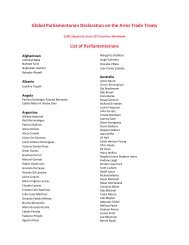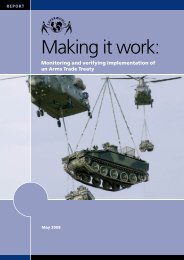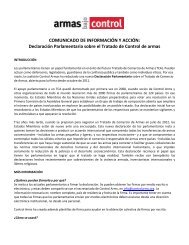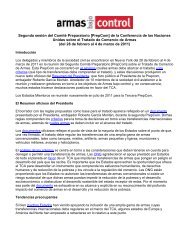1. Preamble/ Principles 2. Goals and Objectives 3 ... - Control Arms
1. Preamble/ Principles 2. Goals and Objectives 3 ... - Control Arms
1. Preamble/ Principles 2. Goals and Objectives 3 ... - Control Arms
You also want an ePaper? Increase the reach of your titles
YUMPU automatically turns print PDFs into web optimized ePapers that Google loves.
Chairman's Draft Paper·3 March 2010Elements<strong>1.</strong> <strong>Preamble</strong>/ <strong>Principles</strong><strong>2.</strong> <strong>Goals</strong> <strong>and</strong> <strong>Objectives</strong>3. Scope4. Criteria for the transfer of conventional arms <strong>and</strong> other related items5.. Implementation <strong>and</strong> Applicationa. National legislation, institutions <strong>and</strong> controls, including record-keeping forimport, export <strong>and</strong> transfer of conventional arms <strong>and</strong> other related itemsb. Licencing procedures <strong>and</strong> criteria assessmentc. End-user certificates/end-use assurancesd. Authorisations <strong>and</strong> Denialse. Enforcementf. Criminalisation of Violations by individuals/entities<strong>1.</strong> Export control violations<strong>2.</strong> Brokering offences·3. Corruption4. 110neylaundering6. International Implementation7. Transparencya. Reportingb. Information Sharingc. Record-keepingd. Consultation8. Compliancea. 11onitoring <strong>and</strong> Verificationb. Denialsc. Settlement of Disputesi. Consultation <strong>and</strong> 11ediation9. International Cooperation <strong>and</strong> Assistancea. International Cooperation <strong>and</strong> Assistancei. National Points of Contactb. Victim Assistance10. Follow up Processes <strong>and</strong> Implementation Support 11echanisma. Costs <strong>and</strong> Administrative Tasks b; 11eetingof States Parties c. Review Conferences1<strong>1.</strong> Final Provisionsa. Review Processesb. Amendmentsc. Reservationsd. Signature, Ratification or Accessione. Entry into Forcef. Withdrawal <strong>and</strong> Denunciationr
2 g. Depository <strong>and</strong> Authentic Textsh. Duration<strong>1.</strong> Relationship with non-State PartiesJ. Relationship between this convention <strong>and</strong> other agreements<strong>1.</strong> qnited Nations Register for Conventional <strong>Arms</strong>1<strong>1.</strong> Programme of Action the Illicit Trade in Small <strong>Arms</strong> <strong>and</strong> Light Weaponsin ~l its Aspects11<strong>1.</strong> International Tracing InstrumentIV. United Nations Transnational Organised Crime Convention FirearmsProtocolv. Other relevant international regimes1<strong>2.</strong> Annexa. Definitions oftransactions or activities covered by the Treaty
3 <strong>Principles</strong><strong>1.</strong> Guided by the purposes <strong>and</strong> principles enshrined in the Charter oftheUnited Nations, <strong>and</strong> reaffinning its respect for <strong>and</strong> commitment tointernational law;<strong>2.</strong> Recognising that disannament, non-proliferation <strong>and</strong> anns control are essential for themaintenance of international peace <strong>and</strong> security;3. Reaffirming the inherent right of all States to individual or collective self-defence inaccordance. with Article 51 of the United Nations Charter;4. Reaffirming the right of self-detennination of all peoples, taking into account theparticular situation of peoples under colonial or other fonns of alien domination orforeign occupation, <strong>and</strong> recognizing the rights of peoples to take legitimate action inaccordance with the Charter ofthe United Nations to realize their inalienable right ofself-detennination. This shall not be construed as authorizing or encouraging any actionthat would dismember or impair, totally or in part, the territorial integrity or politicalunity of sovereign <strong>and</strong> independent States conducting themselves in compliance with theprinciple of equal rights <strong>and</strong> self-detennination ofpeoples;5. Reiterating the general prohibition against the use of force <strong>and</strong> threat of use of force<strong>and</strong> the principles of the peaceful settlement of disputes <strong>and</strong> non-interference in theinternal affairs of States, as embodied by Article 2 of the United Nations Charter;6. Recalling the commitment to the principles of political independence, sovereignequality.<strong>and</strong> territorial integrity of all States, <strong>and</strong> acknowledging that peace <strong>and</strong> security,development <strong>and</strong> human rights are the foundations for collective security; .7. Reaffirming also the right ofall States to territorial integrity <strong>and</strong> politicalindependence;8. Recognising that thecontrol <strong>and</strong> regulation ofthe import, export <strong>and</strong> transfer ofconventional anns <strong>and</strong> related items is done without prejudice to the priorities accordedto nuclear disannament <strong>and</strong> weapons of mass destruction <strong>and</strong> conventional disannament;9. Recognising the absence of commonly agreed international st<strong>and</strong>ards for the transfer ofconventional anns <strong>and</strong> their diversion to the illicit market are contributory factors toanned conflict, serious violations of international human rights law <strong>and</strong> internationalhumanitarian law, the displacement of people, transnational organized crime, terrorism<strong>and</strong> the illicit trade in narcotics, thereby undennining peace, reconciliation, safety, .security, stability <strong>and</strong> sustainable social <strong>and</strong> economic development;10. Acknowledging the right of all States to manufacture, develop, acquire; import, export,transfer <strong>and</strong> retain conventional anns <strong>and</strong> related items <strong>and</strong> capabilities for self- defence<strong>and</strong> security needs <strong>and</strong> in order to participate in peace-keeping operations in accordance-------------------~.~- .. --.
4 with the United Nations Charter. This right does not create any obligation for States to do. so <strong>and</strong> such rights must be exercised in accordance with international law;1<strong>1.</strong> Recognising the legitimate political, security, economic <strong>and</strong> commercial interests ofStates in the import, export <strong>and</strong> transfer of conventional arms <strong>and</strong> related items;1<strong>2.</strong> Recognising the sovereign right of States to determine any regulation of internaltransfers of arms <strong>and</strong> national ownership exclusively within their territory, includingthrough national constitutional protections on private ownership.13. Recalling the obligations of all States to comply with United Nations Security Councildecisions, in particular arms embargoes <strong>and</strong> sanctions,14. Reaffirming their rights <strong>and</strong> obligations under international law; includinginternational human rights law <strong>and</strong> international humanitarian law;15. Mindful ofthe need to prevent the destabilising effects of excessive <strong>and</strong> uncontrolledconventional arms stockpiles <strong>and</strong> to prevent the diversion of conventional arms from thelegal into the illicit market;16. .Recognizing the need to prevent, combat <strong>and</strong> eradicate the irresponsible <strong>and</strong> illicittrade of conventional arms <strong>and</strong> related items <strong>and</strong> the responsibility of all States toeffectively regulate <strong>and</strong> control the import,export <strong>and</strong> transfer ofconventional arms <strong>and</strong>related items; . .17. Recognising that existing national, regional <strong>and</strong> subregional best practices on theimport, export, <strong>and</strong> transfer of conventional arms can play an important role in furtheringthe goals <strong>and</strong> objectives of an <strong>Arms</strong> Trade Treaty;18. Recognising the importance of the universal application of the <strong>Arms</strong> Trade Treaty <strong>and</strong>promoting its universal adherence;19. Recognising that States may adopt more restrictive measures than those provided in the<strong>Arms</strong> Trade Treaty;-
5 <strong>Goals</strong> <strong>and</strong> <strong>Objectives</strong>An <strong>Arms</strong> Trade Treaty will:l. Promote the goals <strong>and</strong> objectives ofthe United Nations Charter; ,<strong>2.</strong> Establish the highest possible common international st<strong>and</strong>ards for the import, export <strong>and</strong>transfer ofconventional arms;3. Prevent, combat, <strong>and</strong> eradicate the illicit transfer, production, <strong>and</strong> brokedng of conventional arms; 4. Contribute to international <strong>and</strong> regional peace, security <strong>and</strong> stability by preventinginternational transfers ofconventional arms that contribute to or facilitate: humansuffering, serious violations of international human rights law <strong>and</strong> internationalhumanitarian law, violations of United Nations Security Council sanctions <strong>and</strong> arms,embargoes <strong>and</strong> other international obligations, armed conflict, the displacement ofpeople, organized crime, terrorist acts <strong>and</strong> thereby undermining peace, reconciliation,safety, security, stability <strong>and</strong> sustainable social <strong>and</strong> economic development; <strong>and</strong>5. Promote transparency <strong>and</strong> accountability in import, export, <strong>and</strong> transfers ofconventionalarms.---~, --"""
6Scope<strong>1.</strong> For the purposes ofthis Treaty, conventional anns shall include any items which fall withinthe following categories:a. Tanksb. Military Vehiclesc. Artillery Systemsd. Military Aircraft (manned or unmanned)e. Military Helicopters (manned or unmanned)f. Naval Vessels (surface <strong>and</strong> submarine vessels anned or equipped for military use)g. Missiles <strong>and</strong> Missile Systems (guided or unguided)h. Small <strong>Arms</strong><strong>1.</strong> Light WeaponsJ. Ammunition for use with weapons defined in subparagraphs (a) - 0)k. Parts or Components speCially <strong>and</strong> exclusively designed for any of the categories insubparagraphs (a)-(k).l. Technology <strong>and</strong> Equipment specially <strong>and</strong> exclusively designed <strong>and</strong> used to develop,manufacture, or maintain any of the categories in subparagraphs (a) - (k).II.The international transactions or activities covered by this Treaty include those listedbelow <strong>and</strong> defined in Annex A.a. Importb. Exportc. Transferd. Brokeringe. Manufacture under foreign licensef. Technology transfer
7 CriteriaI. State Parties shall evaluate all transfers <strong>and</strong> decide whether or not to authorize a transfer ofarms. In reaching the decision whether or not to authorize a transfer of anns, competentnational authorities of States shall apply the following criteria:A. international, Regional <strong>and</strong> Subregional Obligations ofa State<strong>1.</strong> A State Party shall not authorize a transfer from, to, or through its territories ofconventional anns if the transfer would violate any measure adopted by theSecurity Council acting under Chapter VII of the Charter ofthe United Nations, inparticular anns embargoes.<strong>2.</strong> A State Party shall not authorize a transfer of conventional anns from, to, orthrough its territories if the transfer violates any of its other relevant international,regional or subregional obligations or commitments regarding the control <strong>and</strong>regulation of international transfers of conventional anns.B. Potential consequences ofthe arms transfer on peace <strong>and</strong> securityA State Party shall not authorize a transfer of conventional anns ifthere is a substantialrisk that those conventional anns would:<strong>1.</strong> Be used in a manner that would seriously undermine peace <strong>and</strong> security or,provoke, prolong or aggravate internal, regional, subregional or internationalinstability.<strong>2.</strong> Be used to commit or facilitate serious violations of international humanitarianlaw.3. Be used to commit or facilitate serious violations of international human rightslaw.4. . Be used to commit or facilitate serious violations of international law, includinggenocide, crimes against humanity <strong>and</strong> war crimes.5. Seriously impair poverty reduction <strong>and</strong> socio-economic development or seriouslyhamper the sustainable development ofthe recipient State.6. Be diverted to unauthorised end users for use in a manner inconsistent with theprinciples, goals, <strong>and</strong> objectives ofthe Treaty, taking into account the risk ofcorruption.7. Be used in the commission of transnational organized crime as defined in theUnited Nations Convention Against Transnational Organised Crime.8. Be used to support, encourage, or perpetrate terrorist acts.
8 II. States Parties shall make assessments whether to transfer arms on an objective <strong>and</strong> nondiscriminatorybasis, taking into account the nature ofthe arms to be transferred, the potentialuse of the weapon by the end-user <strong>and</strong> assessments made <strong>and</strong> information provided, interalia, by:<strong>1.</strong> Competent bodies of the United Nations, including the Security Council;<strong>2.</strong> A State Party's own competent authorities <strong>and</strong> agencies, including its diplomatic<strong>and</strong> consular missions;3. Relevant international, regional <strong>and</strong> subregional organisations;4. Other States; <strong>and</strong>5. Non-governmental organisations.
9 LInternational Cooperation <strong>and</strong> AssistanceInternational Cooperation <strong>and</strong> Assistance <strong>1.</strong> In fulfilling its obligations under this Treaty each State Party may offer or receiveassistance.<strong>2.</strong> State Parties may offer or receive assistance, inter alia, through the United Nations,international, regional, subregional or national organisations, non-governmentalorganisations, or on a bilateral basis.3. State Parties in a position to do so <strong>and</strong> where appropriate may provide technical,legal, material <strong>and</strong> financial assistance to States Parties to support theirimplementation ofthe Treaty obligations. Such assistance may take the form ofinformation exchange on best practices, legislative <strong>and</strong> legal assistance, <strong>and</strong> industrialcooperation related to the Treaty <strong>and</strong> its practical implementation. State Parties maybuild upon existing customs <strong>and</strong> law enforcement cooperation arrangements, includingthose already established by international, regional <strong>and</strong> subregional organizations.4. Consistent with their respective legal <strong>and</strong> administrative systems, State Partiesmay exchange relevant information <strong>and</strong> best practices on exports, imports <strong>and</strong>transfers of conventional arms.5. State Parties will designate one or more national points of contact to facilitatecooperation <strong>and</strong> information exchange between State Parties, <strong>and</strong> to act as aliaison on all matters relating to the implementation ofthisTreaty.6. State Parties providing <strong>and</strong> receiving assistance under the provisions ofthisArticle shall do so in a manner consistent with existing commitments <strong>and</strong>international instruments_with a view to ensuring the full <strong>and</strong> promptimplementation ofagreed assistance programmes.7. The provisions of this Treaty shall be implemented in a manner that avoidshampering the economic or technological developments of States Parties.II.Victim Assistance<strong>1.</strong> Each State Party in a position to do so, <strong>and</strong> where appropriate, may offer orreceive assistance for the care <strong>and</strong> rehabilitation, <strong>and</strong> social <strong>and</strong> economicreintegration, of victims ofarmed conflict.2~ Such assistance may be technical or material in nature <strong>and</strong> can be provided, interalia, through the United Nations system, international, regional, subregional ornational organisations, non-governmental organisations, or on a bilateral basis, asappropriate.
10AnnexATransactions or activities to be covered by the Treaty<strong>1.</strong> For the purposes ofthis Treaty, the following transactions or activities shall be covered byStates in their national legislation <strong>and</strong> regulations:a. Transfer (inCludes import, export, re-export, temporary transfer, transhipmenttransit, transport, leases, loans, <strong>and</strong> gifts of conventional arms): International armstransfers involve,in addition to the physical movement ofequipment into or" fromnational territory, the transfer oftitle to <strong>and</strong> control over the equipment.b. Brokering: The facilitation by an intennediary who brings together relevant parties <strong>and</strong>arranges or facilitates a potential transaction ofconventional arms in return for someform ofbenefit, whether financial or otherwise.c. Manufacture under foreign license: An agreement whereby a person or entity in theexporting State grants a person or entity in the importing State an authorisation tomanufacture conventional arms which involves technology transfer or the use oftechnology or conventional arms previously supplied by the exporting State.d. Technology transfer: The export, by tangible or intangible means, of infonnation whichis required for the design, development, production, manufacture, assembly, operation,repair, testing,maintenance or modification ofconventional arms.



